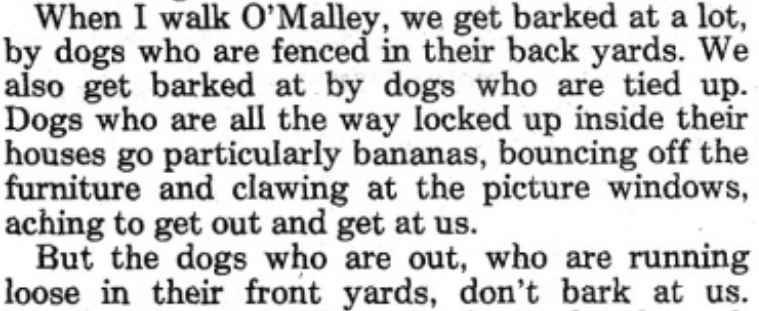Who and That
Here’s the rule: “Who” refers to people, “that” refers to everything else. So you say,
The person who sits next to me stinks.
Not
The person that sits next to me stinks.
Okay, maybe you shouldn’t say either sentence, but you get the idea.
I ran into an exception that works. Maybe we could call this personification. After all, aren’t dogs really people?

Besides, Mike Peterson, of Comic Strip of the Day is a dog person, so maybe that’s a good excuse, too.
PS—Unrelated bonus article: I don’t do politics here, but this appeared yesterday in The Washington Post and it’s about an English teacher correcting someone’s writing. I guess I gotta be proud.
Subscribe to this blog's RSS feed
A Little Tech Writing Advice
This Lunar Baboon comic is a set of instructions. Instructions are common in technical writing.
Look at the second panel. He numbered the instruction. That’s good. But…

He used the future tense! The context of instructions is customary behavior, and for customary behavior, use the present tense, even if it hasn’t happened yet. Instructions should also be in the imperative, so he really should have said, “First, get a wand.” (The first panel describes a single event, so the future is okay here.)
The rest is good, but I have a quibble. In the next-to-last panel he should have said, “…someone who enjoys…” but that’s for another lesson.
Pet Peeve of the Day: Prior
Priority is when something has to come first because of importance or its place in a series of steps. For example, “my wife has a prior claim on my affections.”
If all you mean is earlier of before, say that. Here’s an example of this misuse of prior. Two, actually:
Using our system, we detect anti-adblockers on 30.5% of the Alexa top-10K websites which is 5-52 times more than reported in prior literature. Unlike prior work which is limited to detecting visible reactions (e.g., warning messages) by anti-adblockers, our system can discover attempts to detect adblockers even when there is no visible reaction.
All they mean is earlier. I’m pretty sure these folks aren’t suggesting that the earlier literature and work are more important or ought to be read first.
Should I also mention their misuse of “which” when they should use “that”? Nah, I already covered that.
Academics can be so pretentious. Harrumph.
The Difference Between “That” and “Which”
I usually ignore things like grammar checkers, but Microsoft Word’s grammar checker happens to be pretty good at this distinction. I should add that we have lots of uses for both words, but today we’ll look at only one use. Here’s the rule:
Use “that” in restrictive clauses.
Use “which” in non-restrictive clauses.
Whatever that means, right?
Restrictive means the information is necessary. Non-restrictive means the information is added info; an aside or parenthetical remark.
Restrictive: The list includes an account that has been set up in the general ledger.
Non-restrictive: The list includes uncollected funds, which is what distinguishes this list from the collected balance.
I should add that you need to use a comma before this usage of “which” to show that the remark is parenthetical.
Here’s an example:
We set up an account that includes uncollected funds, which is what distinguishes it from a collected balance account.
A good exercise is to watch for this construction in your daily reading. You will see a lot of people using “which” when they should use “that.” They’re being pretentious. Don’t you be pretentious.
